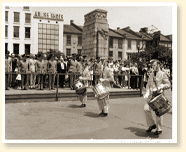

Victory Loan Parade Hamilton Ont., 1942
R.C.A.F. Photograph |
Life on the Homefront: Hamilton, Ontario, a City at War
Hamilton was a city of 155,000 in 1939. It grew to 174,000 by
1945, chiefly because of the rush of workers into war industries. The city had always been an industrial centre. After the doldrums of
the Depression, there were some 35,000 workers in the eight largest
industries; by September 1942, there were more than 60,000. In
addition to the heavy industry of steel-making, plants concentrated
on war materiel. National Steel Car Corporation not only produced
artillery shells, but also manufactured forgings and parts for tanks
and military vehicles. Firestone Tire and Rubber made self-sealing
fuel cells for aircraft and hard rubber tires for tank suspensions,
in addition to automotive and aircraft tires. The city contributed heavily to the armed forces. Two local infantry
and two artillery field batteries, along with other local
units, fought in Italy and North West Europe. As it had during the
First World War, the 40th Field mobilized right in the Hamilton
Spectator offices; it was led by one of the newspaper's editors.
Many Hamilton residents served with other units or with the
or . Dieppe, where the Royal Hamilton Light Infantry was in thick
of the fighting and suffered huge losses, was the greatest single
war tragedy for the city. ( see Dieppe Raid, 19 August 1942 ). There was also military activity in and around the city. The Hamilton
Flying Club managed a elementary flying training school.
It originally operated at
nearby Mount Hope, until that
airport was taken over for the heavier aircraft of No. 33 Air
Navigation School in 1941. HMCS Star, Hamilton's prewar Royal
Canadian Navy Volunteer Reserve unit, became a wartime barracks to
train navy personnel. Stories about the activities of the city's military units and its
war industries, and of Hamiltonians overseas, make up a large part
of the Spectator clippings in the collection. Related Newspaper Articles
English Articles
- Industry Here Feels Stimulus of War Orders
The Hamilton Spectator, 20/10/1939
- Magnificient Effort Made During War's First Year
The Hamilton Spectator, 31/08/1940
- Air Minister Official Party Inspect Field
The Hamilton Spectator, 12/08/1941
- What Is the Victory Chorus? (Advertisement)
The Hamilton Spectator, 04/11/1941
- Ottawa's Decision Revealed by Hon C.W.G Gibson To-Day; to Utilize Large Property
The Hamilton Spectator, 14/08/1942
- Hamilton Man in Africa (Photo and Caption)
The Hamilton Spectator, 15/05/1943
- Corvette and Algerine Types to Be Brought Here For Equipping of Hulls
The Hamilton Spectator, 25/06/1943
- Presume Death of Local Men Aboard Alberni
The Hamilton Spectator, 04/01/1945
- Decorate Graves of R.A.F. heroes
The Hamilton Spectator, 04/06/1945
- British Mayor Thanks Hamilton
The Hamilton Spectator, 06/09/1950
|